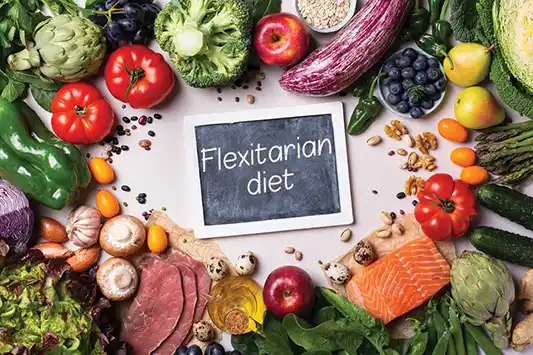Bloating is an uncomfortable part of life that can happen to anyone and be caused by any number of factors, from eating too much too quickly to hormone cycles to gut inflammation and food sensitivities. It can feel like tightness, pressure, fullness, and gassiness in the stomach and lower abdomen, but in the best case scenario it’s a temporary side effect of whatever has triggered it. But sometimes serious bloating and gas stick around—what then?
“When abdominal bloating and distension are chronic [or repeatedly occurring], bothersome, accompanied with pain, and negatively affect daily life, a thorough evaluation [by a medical practitioner] is needed,” says Yi Min Teo, MS, RD, CNSC, a registered dietitian specializing in culturally inclusive digestive health and owner of Herbs and Food.
Figure Out What Foods Cause Bloating for You
Once you’ve had a thorough medical check up and ruled out any serious medical conditions, you might be advised to implement some lifestyle changes, which may include taking a closer look at the food that you consume and limiting certain foods that cause bloating and gas.
There are several reasons why certain foods cause bloating. Teo explains that some foods may draw water into your gut, contain gas, or be fermented (aka “eaten”) by gut bacteria that produce gas as a byproduct. Foods that require you to chew on it for extended periods of time can also introduce excess air into your gut.
Below, registered dietitians share the most common foods that cause bloating, and how to tweak your eating habits to reduce bloating and gas.
Foods That Can Cause Bloating
– Too much fiber all at once.
Fiber is an extremely important nutrient found in fruits, vegetables, and grains. You may have heard that fiber is good for you, and that most people will benefit from having more fiber in their diets. This is all true, and not eating enough fiber can also contribute to constipation and gut health issues—common culprits behind bloating for many people. But here’s the catch: Did you know that suddenly packing your plate with tons of high-fiber foods (or ingesting fiber supplements) all at once can actually backfire and cause bloating?
“When you start incorporating such a large amount of fiber for all three meals and consistently throughout the week, that huge influx of fiber causes extra fermentation to happen in the gut, especially in the colon where some of the fermentable fibers can create extra gas,” Teo explains. “A lot of individuals can experience bloating, sometimes even cramping or pain associated with that.”
There is a happy middle ground for consuming fiber, and you can find it by slowly and steadily adding more fiber into your diet. Reducing the load of fiber in each meal or snack can really help. “The goal is to slowly increase the fiber over time, so your gut has time to adapt,” Teo says.
Another way to support tolerance of fiber is by eating fiber together with protein and carbohydrates, instead of just having fiber on its own, Teo says.
– Foods with added sugar alcohols (like chewing gum).
Sugar alcohols are a type of carbohydrate used to sweeten food and drinks labeled as “sugar-free.” The most common ones you see on the market include:
• sorbitol
• xylitol
• mannitol
• erythritol
Sugar alcohols are fermented in the large intestine, and gas is produced as a byproduct, so having lots of sugar alcohols can cause bloating, says Vandana Sheth, RDN, CDCES, FAND, registered dietitian, certified diabetes care and education specialist, and certified intuitive eating counselor.
One of the most common foods containing sugar alcohols is chewing gum. Besides causing bloating through the presence of sugar alcohols, Teo says the act of chewing the gum actually introduces gas into your digestive system because you’re swallowing more air.
How can you eat sugar-free foods without causing bloating? Read the labels on all sugar-free products, looking out for sorbitol, xylitol, mannitol, and erythritol. Sheth suggests reducing the amount and frequency that you consume food and drink that contain sugar alcohols to curb the bloat, particularly if you’ve noticed this being your main trigger.
– Dairy products (for lactose intolerant or sensitive people).
Lactose is a type of natural sugar found in dairy products. Sixty-eight percent of the world’s population is unable or less able to digest lactose because their body does not make enough lactase enzyme to break it down. People who are lactose intolerant may experience bloating after consuming these items, Teo says. Milk, yogurt, ice cream, soft cheeses, and milk powder (found in milk chocolate and some mashed potato recipes, just to name a few) are some products that are higher in lactose.
How can you eat dairy products without causing bloating? If you are lactose intolerant, Teo advises choosing lactose-free products or purchasing lactase enzyme tablets that you can take just before eating lactose-containing foods.
– Carbonated drinks.
Introducing gas into your stomach is an easy way to cause bloating, which is why carbonated drinks, which are pumped with carbon dioxide, are a potential culprit, Teo points out. You may notice its gassy effects especially after drinking it at a meal that’s larger than your usual meal size.
How can you drink this without causing bloating?
If you’re open to it, replace the carbonated drink with a non-carbonated one at meal times. Sheth suggests switching to flat water with some flavoring, if you find this more palatable compared to plain water. If cutting out carbonated beverages is not an option for you, Sheth says you can definitely still enjoy these fizzy drinks by reducing the amount and frequency you drink them. You can also drink them without a straw to avoid inhaling more air that may contribute to additional bloating.
– High FODMAP foods.
FODMAP stands for fermentable oligosaccharides, disaccharides, monosaccharides, and polyols. While that may sound like a mouthful, in short they are a group of natural sugars found in certain foods that are not completely digested or absorbed in the intestines. Some people’s systems are far more sensitive to high-FODMAP foods and may find that reducing or eliminating them from their diet can alleviate troublesome bloating and gas issues.
“Instead of being digested, FODMAPs pull water into the gut, and they ferment in the colon and produce gas, causing the intestinal wall to stretch and expand,” Teo says.
FODMAPs are found in higher concentrations in certain fruits, vegetables, grains, and dairy products, some of which are highlighted below. Keep in mind that this is not a complete list of high FODMAP foods.
• Fruits: Apples, mangoes, peaches, pears, plums, prunes.
• Vegetables: Garlic, onions, cauliflower, Brussels sprouts, broccoli, cabbage, mushrooms.
• Grains: Barley, wheat, rye.
• Beans and legumes: Chickpeas, beans, lentils.
• Dairy products: Cow’s milk, soft cheeses, yogurt.
Each person has a different threshold for tolerating FODMAPs, Teo reiterates. Even if you don’t have diagnosed irritable bowel syndrome, or IBS, eating five plums in one sitting, for example, introduces a high load of FODMAPs, which can make you feel bloated. She adds that with IBS, the threshold for gas production and distension is a lot lower. Just a quarter of a plum may set off a series of gastrointestinal symptoms, including bloating and even cramping.
How can you eat these foods without causing bloating?
If you’re part of the second group of people, who experience uncomfortable bloating after eating a tiny amount of the food, both Teo and Sheth advise making an appointment to see your doctor as soon as possible. They will first rule out any serious medical conditions that could manifest as bloating, before confirming whether you have IBS.
Once this has been confirmed, a registered dietitian specializing in digestive health will likely be enlisted to implement a Low FODMAP diet. This diet is a temporary one, with the aim of discovering which of the FODMAPs you are sensitive to, and finding out what amount you can tolerate, Teo says.
By the end of the Low FODMAP diet, you will come away with a list of foods you can have, what portion size you can tolerate without symptoms, and what alternatives to include in your diet if you are not able to tolerate certain foods. For example, if Sheth’s clients have a low tolerance for beans and lentils, Sheth provides them with useful tips to lower the FODMAP content, like soaking the beans and lentils overnight first before cooking them in a pressure cooker.
A lot of the foods listed above, including many fruits, vegetables, grains, and dairy, are very nutritious, notes Sheth. Working together with healthcare professionals, you will be able to find ways to enjoy these foods in a way that doesn’t trigger or exacerbate bloating, all while getting the nutrients you need. And if you absolutely cannot tolerate even a small amount, Sheth says registered dietitians are trained to help you find other ways to get those crucial nutrients into your diet.
– Seraphina Seow
(Seraphina is a health writer with a background as a registered dietitian.)
Proposed bill would consolidate control of Mohave County public schools
A controversial bill proposed by two Mohave County legislators would implement a pilot program consolidating control of the county’s public school districts under a single elected official.
House Bill 2717, sponsored by State Reps. John Gillette (R-Kingman) and Leo Biasiucci (R-Lake Havasu City), would transfer many powers held by local school boards to the Mohave County School Superintendent’s office for a 5-year pilot program starting in 2025. The bill would also implement a similar consolidated administration pilot program in neighboring La Paz County.



























